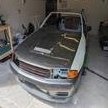180sx Advice
Announcements
-
Similar Content
-
Latest Posts
-
@Haggerty this is your red flag. In MAP based ECU's the Manifold pressure X RPM calculation is how the engine knows it is actually...running/going through ANY load. You are confusing the term 'base map' with your base VE/Fuel table. When most people say 'base map' they mean the stock entire tune shipped with the ECU, hopefully aimed at a specific car/setup to use as a base for beginning to tune your specific car. Haltech has a lot of documentation (or at least they used to, I expect it to be better now). Read it voraciously.
-
I saw you mention this earlier and it raised a red flag, but I couldn't believe it was real. Yes, the vacuum signal should vary. It is the one and only load signal from the engine to the ECU, and it MUST vary. It is either not connected or is badly f**ked up in some way.
-
By Murray_Calavera · Posted
@Haggerty you still haven't answered my question. Many things you are saying do not make sense for someone who can tune, yet I would not expect someone who cannot tune to be playing with the things in the ECU that you are. This process would be a lot quicker to figure out if we can remove user error from the equation. -
If as it's stalling, the fuel pressure rises, it's saying there's less vacuum in the intake manifold. This is pretty typical of an engine that is slowing down. While typically is agree it sounds fuel related, it really sounds fuel/air mixture related. Since the whole system has been refurbished, including injectors, pump, etc, it's likely we've altered how well the system is delivering fuel. If someone before you has messed with the IACV because it needed fiddling with as the fuel system was dieing out, we need to readjust it back. Getting things back to factory spec everywhere, is what's going to help the entire system. So if it idles at 400rpm with no IACV, that needs raising. Getting factory air flow back to normal will help us get everything back in spec, and likely help chase down any other issues. Back on IACV, if the base idle (no IACV plugged in) is too far out, it's a lot harder for the ECU to control idle. The IACV duty cycle causes non linear variations in reality. When I've tuned the idle valves in the past, you need to keep it in a relatively narrow window on aftermarket ecus to stop them doing wild dances. It also means if your base idle is too low, the valve needs to open too much, and then the smallest % change ends up being a huge variation.
-
I guess one thing that might be wrong is the manifold pressure. It is a constant -5.9 and never moves even under 100% throttle and load. I would expect it to atleast go to 0 correct? It's doing this with the OEM MAP as well as the ECU vacuum sensor. When trying to tune the base map under load the crosshairs only climb vertically with RPM, but always in the -5.9 column.
-







Recommended Posts
Create an account or sign in to comment
You need to be a member in order to leave a comment
Create an account
Sign up for a new account in our community. It's easy!
Register a new accountSign in
Already have an account? Sign in here.
Sign In Now